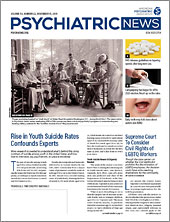More than 25% of high school seniors reported past-month vaping of nicotine in 2019, and more than 40% have ever tried it, according to the latest data from the Monitoring the Future survey.
The researchers sought to assess whether U.S. secondary schoolers’ vaping of nicotine continued to increase in 2019, after the previous year’s record increase, the largest for any substance tracked in the 44-year history of the survey (
Psychiatric News). In fact, the prevalence of nicotine vaping more than doubled across the board since 2017, with more than 20% of 10th graders and 9% of 8th graders reporting past 30-day use in 2019.
“I think it’s important for psychiatrists and others to really drive home how debilitating addiction can be,” Richard Miech, Ph.D., principal investigator of the Monitoring the Future survey and a professor at the University of Michigan, told Psychiatric News. “Many adolescents and adults believe that vaping nicotine poses little health risk, a belief promoted by the vaping industry. They tend to overlook that nicotine is still in there. Growing numbers of adolescents are getting suspended from school, kicked off high school sports teams, and are generally experiencing negative consequences because they are not able to control their cravings for nicotine.”
Funded by the National Institute on Drug Abuse, the Monitoring the Future survey conducted by the University of Michigan tracks substance use annually among 8th, 10th, and 12th graders at hundreds of schools nationwide. The researchers issued the vaping results of the survey several months early this year, as the number of severe vaping-related lung injuries rose to 2,051 nationwide, with 39 reported deaths (as of Nov. 5), according to the Centers for Disease Control and Prevention (CDC). Eight in 10 of those injured have been under 35 years old.
As a new principal investigator of the Monitoring the Future project, Miech said one of his goals has been to get the most critical data disseminated more quickly. “Ideally, we want to get the information to policymakers as policy is being made,” he explained.
The substantial levels of daily vaping reported by adolescents in 2019 suggests the development of nicotine addiction in a sizable number, Miech said. In fact, 12% of 12th graders, 7% of 10th graders, and 2% of 8th graders reported daily vaping. “New efforts are needed to protect youth from using nicotine during adolescence, when the developing brain is particularly susceptible to permanent changes from nicotine use and when almost all nicotine addiction is established,” Miech and colleagues wrote in an article in the October NEJM.
The Food and Drug Administration (FDA) said it still intends to clear the market of e-cigarette products in flavors that appeal to kids, such as gummy worm, cotton candy, and cookies n’ cream. “The agency intends to finalize a compliance policy in the coming weeks,” Stephanie Thull, an FDA spokesperson, told Psychiatric News. “The FDA plans to share more on the specific details of the plan and its implementation soon.”
Miech said he thinks banning all nontobacco-flavored vaping products would go a long way toward reducing teen vaping. “If teens’ first experience with vaping was associated with tobacco flavor, I believe they would conclude that vaping is gross and not vape anymore,” he said.
Miech also would like to see a tax on the vaping industry that is directly indexed to the prevalence of teen use, as indicated by the Monitoring the Future survey or another national survey, to remove the financial incentive of promoting teen vaping. The higher the teen prevalence of vaping products, the higher the tax. ■
“Trends in Adolescent Vaping, 2017-2019 is posted
here.

